Social Care Services, Scotland, 2016
Latest national figures for Social Care services provided or purchased by Local Authorities in Scotland.
This document is part of a collection
4. Working Age Adults - Clients aged 18 to 64
This section of the report provides more detail on the 47,630 Social Care clients aged 18 to 64 in the survey.
4.1 Home Care for adults aged 18 to 64
There were 10,560 Home Care clients aged 18-64 in 2016. Figure 21 shows that the rate of Home Care clients aged 18 to 64 per 1,000 population decreased in 2016 to 3.1 per 1,000 population from 3.3 per 1,000 population in 2015.
Figure 21: Home Care clients per 1,000 population aged 18-64, 2007 to 2016
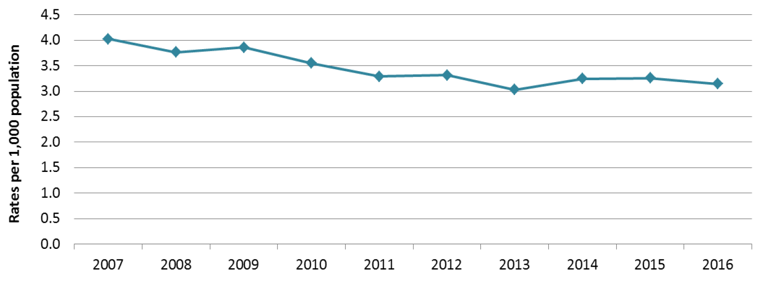
Source: Scottish Government Social Care Survey 2013-2016, Home Care Census 2007-2012
Population data: National Records for Scotland mid-year population estimates up to 2015 (latest available)
The number of people aged 18 to 64 receiving Home Care has decreased in 2016, following increases observed from 2013 - 2015 (Figure 22). The number of Home Care hours provided to 18-64 year olds has also decreased this year following increases from 2013 - 2015.
Figure 22: Home Care clients aged 18-64 and hours provided, 2010 to 2016
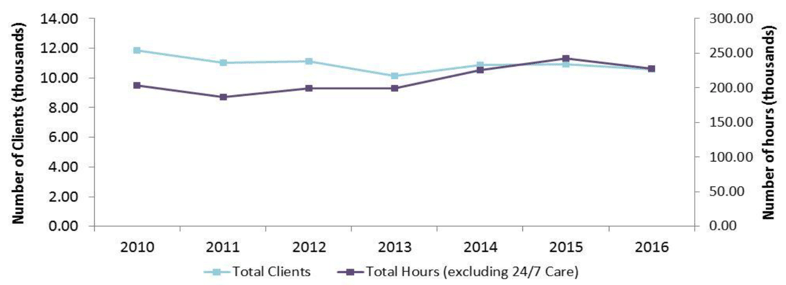
Source: Scottish Government Social Care Survey 2013-2016, Home Care Census 2010-2012
Just under half (49%) of Home Care clients aged 18 to 64 received less than 10 hours of care per week (Figure 23), compared to 65% for older people (see Figure 16, Section 3). 13% of clients aged 18 to 64 received more than 50 hours of care per week compared with only 1% of clients aged 65+.
Figure 23: Distribution of Home Care hours, clients aged 18 to 64, 2016
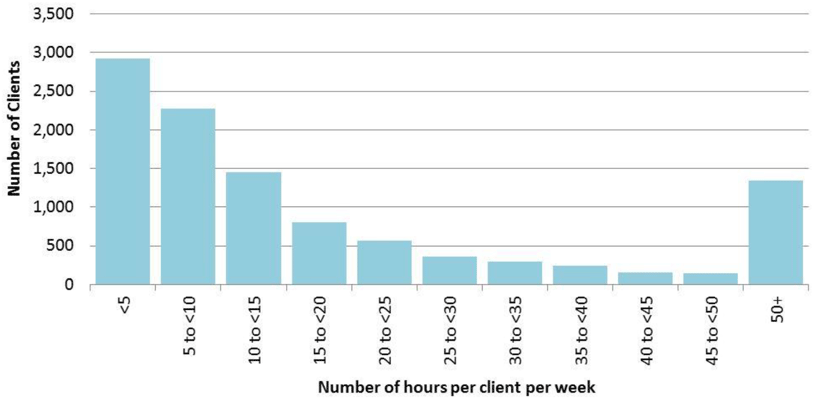
Based on 10,560 home care clients aged 18-64.
Source: Scottish Government Social Care Survey 2016
Working age adults are less likely to use Local Authority run services: only 24% of clients aged 18 to 64 received their care solely from Local Authorities (Table 4), compared with 53% for clients aged 65+ (Table 2). Only 11% of Home Care hours for clients aged 18 to 64 were provided solely by Local Authorities in 2016, compared with 43% for those aged 65 and over.
There is also a greater discrepancy between the mean and median numbers of hours for clients aged 18 to 64 than was seen for clients aged 65+ (Table 2). This is due to the distribution of home care hours seen in Figure 23 and in particular the 13% of clients who receive 50 or more hours of care each week.
Table 4: Home Care by Service Provider for clients aged 18 to 64, 2016
| Service Provider | Number of clients | Client hours | Average (mean) hours per week | Average (median) hours per week | ||
|---|---|---|---|---|---|---|
| Local Authority only | 2,530 | 24% | 24,900 | 11% | 10 | 6 |
| Private sector only | 4,110 | 39% | 77,300 | 34% | 19 | 9 |
| Voluntary sector only | 3,290 | 31% | 110,100 | 48% | 33 | 18 |
| LA plus private | 330 | 3% | 6,200 | 3% | 19 | 14 |
| LA plus voluntary | 90 | 1% | 1,900 | 1% | 22 | 13 |
| All other combinations | 190 | 2% | 7,700 | 3% | 41 | 26 |
| Total | 10,560 | 100% | 228,100 | 100% | 22 | 10 |
Source: Scottish Government Social Care Survey 2016
Figure 24 shows people aged 18-64 who receive a home care service by the principal reason they are receiving care (their 'client group'). The main reasons that people in this age group require home care is because they have a learning disability (36% of clients) or a physical disability (34% of clients). An additional 3% of clients aged 18-64 have both a Learning and Physical disability.
Figure 24: Home Care Clients aged 18 to 64, by client group, 2016
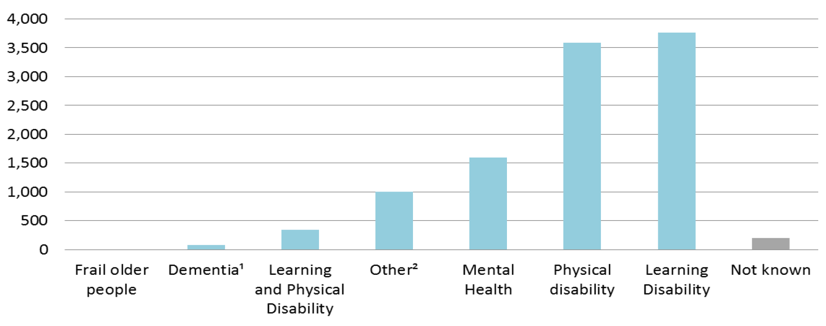
¹ Dementia is known to be under recorded in the social care management information system.
² "Other" includes addictions, palliative care and carers.
Based on 10,560 home care clients aged 18-64.
Source: Scottish Government Social Care Survey 2016
Figure 25 shows that of the Home Care clients aged 18 to 64 for whom living arrangements are known, 38% live alone. This is lower than the 53% of clients aged 65+ who live alone (Figure 18).
Figure 25: Living arrangement of clients¹ aged 18 to 64 receiving Home Care services, 2016
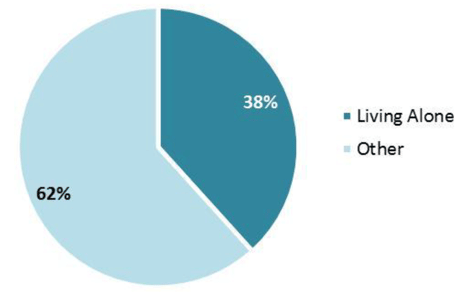
¹ Based on 6,490 clients for whom Living Arrangements were known. Living arrangements information was unavailable for 4,060 clients.
Source: Scottish Government Social Care Survey 2016
4.2 Community Alarm / Telecare Services for clients aged 18 to 64
There were 16,850 people aged 18-64 in receipt of a Community Alarm and/or Telecare service in the year 2015-16. As explained in Section 3 of this report, in 2015 Local Authorities were asked to provide data on all clients receiving Community Alarms/Telecare at any point during the financial year; previously they only recorded those receiving the service during the March census week (Figure 26).
Figure 26: Clients aged 18 to 64 receiving Community Alarm and/or another Telecare service, 2011 to 2015-16
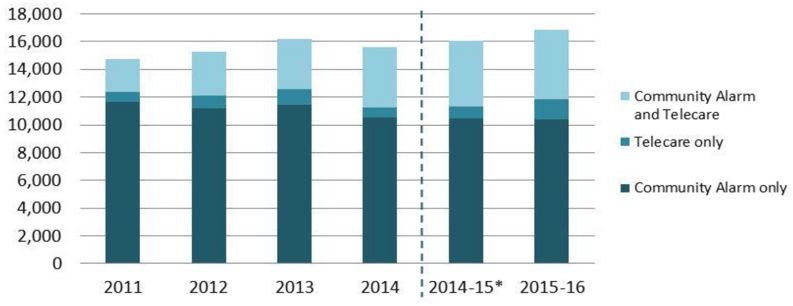
¹ From 2015 Local Authorities were asked to record all clients receiving Community Alarms/Telecare at any time during the financial year. Previously only clients receiving these services during the March census week were recorded.
Source: Scottish Government Social Care Survey 2013-2016, Home Care Census 2011-2012
4.4 Direct Payments for clients aged 18 to 64
In 2015-16, an estimated 3,650 people aged 18 to 64 received Direct Payments to purchase the care services they need. The total amount spent by Local Authorities on Direct Payments for this age group was estimated as £62 million. As with the 65+ age group, this saw the continuation of the trend of increasing numbers of people receiving Direct Payments, which has been the case each year since 2009-10 (Figure 27).
Figure 27: People aged 18 to 64 who received Direct Payments¹, 2009-10 to 2015-16
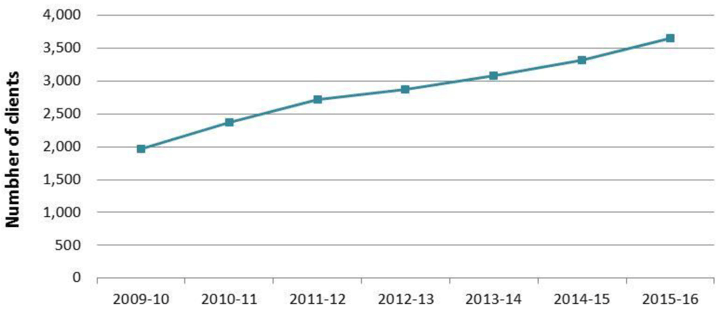
¹ Direct Payments totals include an estimate for East Renfrewshire council in 2014-15 - see 5.5 (background notes).
Source: Scottish Government Social Care Survey 2013-2016, Self-Directed Support/Direct Payments Survey 2010-2012
Table 5 shows the breakdown of clients aged 18 to 64 receiving Direct Payments to purchase the care services they need. Physical Disabilities and Learning Disabilities are the primary reason for clients in this age group receiving Direct Payments.
Table 5: Direct Payments for clients aged 18 to 64, by client group, 2015-16
| Client Group | Number of clients** | Expenditure (£ millions) |
Mean 1 value of direct payments |
Median 2 value of direct payments |
|---|---|---|---|---|
| Physical disability | 1,400 | £23.6 | £17,000 | £11,000 |
| Learning disability**** | 1,230 | £22.8 | £19,000 | £10,000 |
| Mental Health | 240 | £2.0 | £8,000 | £5,000 |
| Dementia*** | 20 | £0.2 | £11,000 | £6,000 |
| Other | 630 | £11.4 | £18,000 | £13,000 |
| Not known | 140 | £1.3 | £10,000 | £6,000 |
| All* | 3,650 | £62.4 | £17,000 | £10,000 |
* The expenditure figures presented for "All" clients aged 18 to 64 receiving Direct Payments have been adjusted to account for missing financial data from Angus council, so are slightly higher than the sum of individual client groups
** Some clients receive more than one direct payment
*** Dementia is known to be under recorded in the social care management information system
**** Learning Disability includes clients with both a Learning Disability and Physical Disability.
1 The Mean denotes the "average" value of direct payments, i.e. the sum of all payments divided by the number of payments (rounded to nearest £1,000)
2 The Median denotes the "middle" value of direct payments, i.e. the value at which half of the payments are less and half are more (rounded to nearest £1,000)
Source: Scottish Government Social Care Survey 2016
Contact
There is a problem
Thanks for your feedback